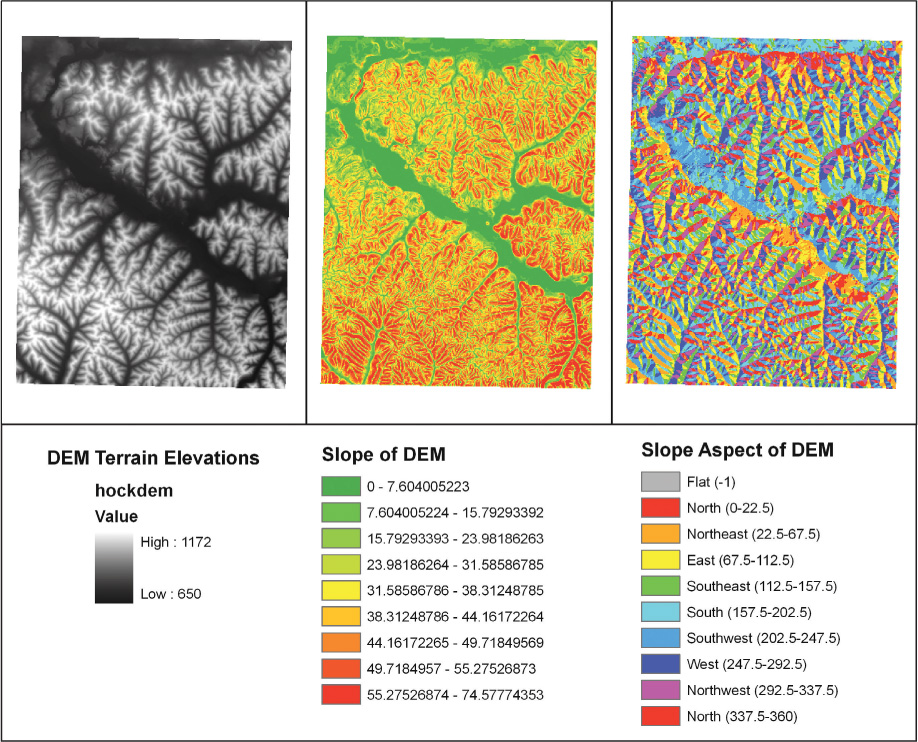13.3 What Is a DEM?
DEM Digital Elevation Model—a representation of the terrain surface, created by measuring a set of equally spaced elevation values
A DEM is a Digital Elevation Model, a specific type of model of the terrain and landscape that’s produced by the USGS and others. A DEM is based on regularly spaced point data of elevations, but it can be converted to a raster grid representation (see Chapter 5) for use with other geospatial data, such as satellite imagery or GIS layers. In grid format, the elevation values are represented by the grid cell value, while the grid resolution represents the size of the cell being measured. Thus, DEM resolution is measured in much the same way that we measure the resolution of a remotely sensed image (see Chapter 10). If a DEM has 30-meter resolution, then each of the DEM’s raster grid cells is set up at 30 meters in size.
NED the National Elevation Dataset, which provides digital elevation coverage of the entire United States
The USGS has numerous types of DEMs available, depending on the size of the area being covered and the DEM resolution. The USGS distributes this elevation data as a free download via the NED (National Elevation Dataset). The purpose of the NED is twofold: to have a digital elevation product that covers the entire United States at the best possible resolution, and to eliminate any gaps in the data. The NED is designed to be “seamless,” insofar as its data uses the same datum, projection, and elevation unit. With the NED, users can first select which sections of the national elevation dataset they need and then download those areas.
NED data is made freely available online via the USGS National Map, a very versatile online utility for downloading geospatial data (see Chapter 15 for more about the National Map itself, and also Hands-on Application 15.2: The National Map Viewer for instructions on how to obtain various GIS datasets, including NED). With the National Map, you can first specify the geographic region for which you require data, and then download multiple data sets (including NED data) for that region. NED data is available at 1 arc second (about 30-meter), 1/3 arc second (about 10-meter), and 1/9 arc second (about 3-meter) resolutions, depending on the region. In addition, US Topos and high-resolution orthoimagery are among the many other datasets available for download from the National Map.
viewshed a data layer that indicates what an observer can see and cannot see from at particular location due to terrain
slope a measurement of the rate of elevation change at a location, found by dividing the vertical height (the rise) by the horizontal length (the run)
slope aspect the direction that a slope is facing
With terrain data, many different types of terrain analysis can be performed. DEMs are used in geospatial technology for creating viewsheds—maps that show what can be seen—or not seen—from a particular vantage point. A viewshed is used for determining how far a person’s visibility is (that is, what they can see) from a location before his or her view is blocked by the terrain. DEMs are also used for a variety of hydrologic applications, like calculating the accumulation of water in an area or delineation of stream channels or watersheds.
DEMs can be used to derive a new dataset of slope information—rather than elevation values, slope represents the change of elevations (and the rate of change) at a location by calculating the rise (vertical distance) over the run (horizontal distance). When a slope surface is created from a DEM, information can be derived not just about heights, but also about the steepness or flatness of areas. Similarly, a surface of slope aspect can be computed, which will show (for each location) the direction that the slope is facing. Now, you not only have information about where the steepest slopes are located, but also about whether they are north-facing, east-facing, and so on. Figure 13.7 shows a comparison of a DEM with the slope and slope aspect maps derived from it.

425